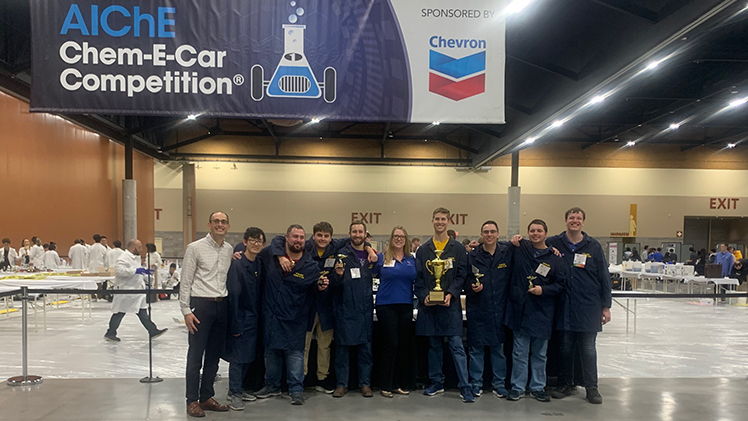The University of Toledo Chem-E Car Team recently took first place for the second year in a row at the 2022 American Institute of Chemical Engineers (AIChE) Annual Student Conference Chem-E Car Competition in Phoenix, competing against 35 other universities worldwide. They are only the second university team in the history of the Chem-E Car Competition to win back-to-back international championships.
“We are very proud of the students, their dedicated advisor Dr. Matthew Liberatore and their sponsors: Formlabs, Nexus Engineering, NSG and Cliffs,” said Dr. Maria Coleman, professor and chair of chemical engineering in the College of Engineering, and associate director of the Polymer Institute.

The UToledo Chem-E Car Team poses for a photo after they took first place for the second year in a row at the 2022 American Institute of Chemical Engineers (AIChE) Annual Student Conference Chem-E Car Competition in Phoenix.
“Winning this incredibly challenging competition for the second year is a testament to their hard work and commitment. Our chemical engineering community knows what an accomplishment this is.”
The goal of the Chem-E Car competition is to create a shoebox-sized car powered by a chemical reaction that will travel a target distance and stop accurately by a chemical reaction.
One hour before the competition, the target distance was announced, meaning all teams had 60 minutes to determine the appropriate number of chemical reagents to stop their chem-e car at the target distance based on their car’s velocity and previous chemical reaction stopping mechanism calibration curves.
During the competition, all teams were given two opportunities to stop their car as close to the target distance as possible, and their final score was based on the closest run of the two.
The target distance during the competition was 22.0 meters, and the Rocket chem-e car stopped just 30.4 centimeters from the target distance to seize the victory in the International Chem-E Car Competition. Typically, each team is required to change both the propulsion and stopping reactions. That rule was suspended, however, for the 2022 season to encourage more teams to compete due to a dip in competition attendance since COVID.
“Our team wanted the challenge of starting from scratch with entirely new reactions, despite not being required to, so this season our car is entirely new,” said Jonathan Bonkoski, a UToledo Chem-E Car Team co-captain along with Derek Etzle, both of whom are seniors studying chemical engineering. “Our 2021 car, named Zincasaurus, used a zinc-nickel battery and a chameleon reaction as the stopping mechanism, while our new car, Acid Reign, uses a homemade lead acid battery and a vitamin C clock stopping the reaction.
“This year’s car was created by extensive use of Formlabs’ resins and 3-D printers. The use of Formlabs resins allowed for safer containment, better battery performance, increased chemical resistance and increased durability of 3D-printed parts. The car’s name, Acid Reign, was created as a play on two things: that the car is powered by a lead acid battery and that UToledo was — and now continues to be — the reigning champs.”
During the first round of the competition, Acid Reign stopped 3.15m past the 22.00m target, finishing the first round with a ranking of sixth place. The multi-disciplinary team (there is one mechanical engineering technology member among the chemical engineers) honed in on their stopping reaction, with the car stopping just 30.4cm short of the target for the second run. The Rocket engineers then waited in suspense, as they were the third to run out of the 36-car lineup, before celebrating being back-to-back champs.
The team also received the first-place award for having the best Chem-E Car poster presentation, followed by the New Jersey Institute of Technology, Universidad Autónoma de Nuevo León, University of Florida and University of Toronto.
“The day prior to the competition, each team is asked to give a 3-to-5-minute presentation describing how the car works,” Bonkoski said. “We received the first-place award for having the best poster presentation. I attribute this to the strong communication and presentation skills taught in UToledo Engineering courses.”
The second-place through fifth-place teams for the poster competition were Missouri University of Science and Technology (35 cm), followed by the University of Patras (Greece) (36 cm), Trine University (36.8 cm) and University of Kentucky (46 cm).
Teammates critical to the team’s success, Bonkoski said, were senior Nicholas Trumbull, a four-year member and propulsion team lead who is studying chemical engineering, and sophomore Alex Martineau, the stopping reaction team lead who also is studying chemical engineering.
“I couldn’t be prouder of all the incredible work our team has done in the past year,” he said. “While we have spent several hundred hours of time spent building, testing, and optimizing the car, none of it would have been possible without support from UToledo and our sponsors.”